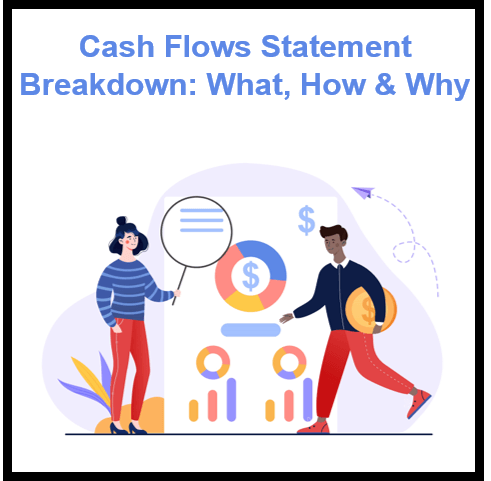A cash flow statement is a financial tool that details the amount of money coming in and going out of a business. It provides managers with critical information on how to manage their businesses, making it one of the most important documents for any company to have.
A cash flow statement can be used for : monitoring financial performance, analyzing working capital requirements, forecasting future liquidity needs, determining dividend payment decisions, and allocating resources.
Here are some key points to consider when creating your cash flow statements:
What is the purpose? Most companies use them to monitor financial performance and analyze working capital needs.
How does it work? A simplified example would be looking at all the income that comes into the company and subtracting what goes out (expenses).
Why do you need one? Cash flows statements provide insight into whether the company will survive long-term and what they should do to avoid bankruptcy – whether they should borrow.
What is a cash flow statement?
A cash flow statement is a financial tool that details the amount of money coming in and going out of a business. It provides managers with critical information on how to manage their businesses, making it one of the most important documents for any company to have.
How does it work?
A company’s cash flow statement is an important piece of information for any business. It provides a snapshot of the organization’s financials and can be used to help make decisions about how to manage the business.
The first section of the cash flow statement, cash flow from operating activities, shows what happens when a company has income or expenses that are not related to investing or financing activities. For example, the sale of inventory would be included in this section.
The second section, investing activities, includes things like buying equipment and making investments. The third section, financing activities, includes things like issuing debt and paying off debt.
A cash flow statement is made up of three parts:
Cash receipts- all income your company receives.
Cash payments- all the costs your company pays for, like salaries, supplies, and marketing.
Investing activities- any money spent on assets that will last more than one year (e.g., purchasing new equipment).
The first step to create a cash flow statement is to determine what goes into each category. Once you decide how much should go into each category, you follow these steps:
1. Add up everything in the cash receipt column
2. Subtract all expenses in the cash payment column
3. Figure out the net change in cash position by subtracting what you had at the beginning of the period from what you have at the end of the period
4. Add up all other investing activities and subtract them from what’s left over.
Why do you need one?
Cash flow statements provide insight into whether the company will survive long-term and what they should do to avoid bankruptcy—whether they should borrow, raise more capital, or cut back on expenses.
If you’re having trouble balancing your cash flow statement, it may be time to update your budget. If you don’t know what your cash flow is like on a monthly basis, try downloading one of these free cash flow templates. They’ll help you track all income and expenses in an organized way.
Ultimately, if you want to understand how your business is doing financially, invest the time to create a detailed cash flow statement. It will give you essential information about your business that can help you make smart decisions for years to come!
A cash flow statement is very easy to make. Here are the steps to follow:
1. List each expense by date when it happened
2. List each income by date when it happened
3. Subtract the expenses from the income, and write the resulting figure in a row below
4. Add up all of the figures in a row and write it at the bottom of that row
5. Repeat steps 1-5 until you have an end balance or until you reach a certain number of rows (usually 10)
The importance of a cash flow statement
A cash flow statement is a document that details the amount of money coming in and going out of a business. It provides managers with critical information on how to manage their businesses, making it one of the most important documents for any company to have.
Drawbacks of not having a cash flow statement
There are many drawbacks to not having a cash flow statement, but there are two main ones:
1. You can’t track how much money is coming in and going out of the company
2. You don’t know what you need to do to prevent bankruptcy.
The first drawback is pretty self-explanatory – if you don’t know how much money is coming in and going out of the company, then you won’t be able to forecast your future liquidity needs or allocate resources accordingly. The second drawback really highlights one of the main reasons why every company should have a cash flow statement: it helps avoid bankruptcy.
Without a cash flow statement, you won’t know when your business will fail – making planning for the future difficult. If you only know that your business will fail once it’s already happening, it’s hard to plan ahead and manage resources effectively.
What does it do?
The cash flow statement
A cash flow statement is an important financial tool that provides managers with information on how to manage their businesses. It gives them a breakdown of income and expenses and tracks the business’ cash.
Cash flow statements can be used for: Monitoring financial performance, analyzing working capital requirements, forecasting future liquidity needs, determining dividend payment decisions, and allocating resources.
Conclusion
A cash flow statement is a great tool for any business. With this information, managers can make smarter decisions about their business.
If you’re interested in learning more about how we can help you create a solid cash flow statement, we’d be happy to put one together for your business!




22 thoughts on “Cash Flow Statement Breakdown: What It Is, How It Works, and Why You Need One””
… [Trackback]
[…] Read More here to that Topic: skillfine.com/cash-flow-statement-breakdown/ […]
… [Trackback]
[…] Read More Info here on that Topic: skillfine.com/cash-flow-statement-breakdown/ […]
… [Trackback]
[…] Read More on on that Topic: skillfine.com/cash-flow-statement-breakdown/ […]
… [Trackback]
[…] Here you can find 54614 more Info to that Topic: skillfine.com/cash-flow-statement-breakdown/ […]
… [Trackback]
[…] Read More Info here on that Topic: skillfine.com/cash-flow-statement-breakdown/ […]
… [Trackback]
[…] Info on that Topic: skillfine.com/cash-flow-statement-breakdown/ […]
… [Trackback]
[…] There you can find 35586 additional Information on that Topic: skillfine.com/cash-flow-statement-breakdown/ […]
… [Trackback]
[…] Read More on on that Topic: skillfine.com/cash-flow-statement-breakdown/ […]
… [Trackback]
[…] Here you will find 7896 additional Information to that Topic: skillfine.com/cash-flow-statement-breakdown/ […]
… [Trackback]
[…] Find More here on that Topic: skillfine.com/cash-flow-statement-breakdown/ […]
… [Trackback]
[…] Find More Information here to that Topic: skillfine.com/cash-flow-statement-breakdown/ […]
… [Trackback]
[…] There you can find 23546 additional Information to that Topic: skillfine.com/cash-flow-statement-breakdown/ […]
… [Trackback]
[…] There you will find 81780 more Information on that Topic: skillfine.com/cash-flow-statement-breakdown/ […]
… [Trackback]
[…] There you will find 39671 additional Information to that Topic: skillfine.com/cash-flow-statement-breakdown/ […]
… [Trackback]
[…] Find More here to that Topic: skillfine.com/cash-flow-statement-breakdown/ […]
I am so grateful for your article post.Really thank you! Want more.
Your point of view caught my eye and was very interesting. Thanks. I have a question for you.
hlhbpkulv hyvei wdqkguo sdwq erpdrancezpbxsj
511044 11553I havent checked in here for some time because I thought it was getting boring, but the last few posts are genuinely great quality so I guess Ill add you back to my daily bloglist. You deserve it my friend. insurance guides 167932
336254 124235Directories such given that the Yellow Websites require not list them, so unlisted numbers strength sometimes be alive more harm than financial assistance. 48818
94868 529680Largest lover messages were made to share it along with your and gives honour of the bride and groom. Extremely sound systems facing unnecessary throngs of men and women really should take into account each of our valuable concept of all presenting, which is ones trailer. finest man toasts 520211
689999 905691Exceptional read, I lately passed this onto a colleague who has been performing slightly research on that. And the man in fact bought me lunch because I came across it for him smile So allow me to rephrase that: Appreciate your lunch! 675296